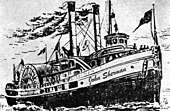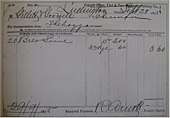SS John Sherman
The SS John Sherman was a United States sidewheeler ship of the 1870s used for ferry service across Lake Michigan. She went between the states of Michigan and Wisconsin. The ship was the first of the commercial ferries used by the Pere Marquette Railroad for transporting freight and passengers. She preceded additional ferries that ultimately became a fleet of ferries for the Chesapeake and Ohio Railroad. It led to the development of the largest train ferry service in the world.

History


The Flint and Pere Marquette Railroad received a land grant in 1857 from the United States government to construct a railroad westwards from Flint, Michigan to the eastern shore of Lake Michigan. As early as 1859, a railroad ferry service across Lake Michigan was considered as a shorter route to Wisconsin rather than going all the way around the south end of Lake Michigan. The western terminus of the new railroad could have been in either Oceana County or Mason County, Michigan. Through the influence of James Ludington (founder of the village of Pere Marquette) the western terminus of the railroad was determined to be at Mason County where the village of Pere Marquette was located. The railroad received its "Pere Marquette" portion of its name from the village in northwestern Michigan.[1] The village was renamed "Ludington" in 1873. The railroad was completed on December 18, 1874.[2]
A privately owned side-wheel steamboat, John Sherman had already started a ferry service across Lake Michigan in 1873.[3][4] The railroad company hired the cross-lake ferry service from Ludington to Sheboygan, Wisconsin, on June 25, 1874. They then initiated a public commercial package freight service across Lake Michigan on May 31, 1875. [2] The vessel was 175 feet (53 m) long.[5] It shuttled packaged freight, grain, and people across Lake Michigan between Ludington and Sheboygan, Wisconsin.[6] The ship commander was Captain John W. Steward.[7]
After the one season in 1875 the vessel was found to be too small for the volume of freight on the route and was discontinued.[1] The craft was then rebuilt in 1877 as a passenger steamer operating out of Detroit. In 1879, she was made into a barge and served that purpose until 1893 when she was scrapped. When she was converted into a barge her engines were not used and went into the boat Alaska and then in 1890 into the boat Frank E. Kirby.[8]
In 1882, the F&PM railroad company had built two wooden freighters to replace John Sherman. They were numbered #1 and #2 and shuttled packaged freight, bulk grain, and passengers between Ludington and Milwaukee.[9] Other vessels were added to the fleet as the years went on and were given the next highest number sequentially as they were added.[10] The railroad company fleet of steamers started carrying complete train freight cars in 1896 and became Pere Marquette Railroad's train ferry fleet—largest in the world by 1905.[11][12][13] This ultimately became the Chesapeake and Ohio's Lake Michigan fleet, the world's largest and fastest lake carferries.[14][15]
Description
The vessel was a break-bulk transporter. That meant that the freight was unloaded from the rail car and loaded onto the ship by hand, rather by packages or by bulk into large ship containers. The freight material was then transported across Lake Michigan. At the other end the freight was unloaded by hand and reloaded into other freight cars at the port the vessel arrived at.[16] All the cross-lake ferries until 1896 were of this type.[17]
References
- Hilton, George Woodman (2003). The Great Lakes Car Ferries. Montevallo Historical Press. p. 93. ISBN 978-0-9658624-3-1 – via Google Books.
- Ludington Daily News (1997). Ludington's Carferries: The Rise, Decline & Rebirth of a Great Lakes Fleet, 1874–1997. Ludington Daily News. p. 6. OCLC 38735177 – via Google Books.
- Great Lakes Historical Society (1949). Inland Seas. Great Lakes Historical Society. p. 116. OCLC 937947524 – via Google Books.
- Barton, Thomas W. (August 2, 1998). "Lake Michigan Ferry Service Through The Years". Chicago Tribune. Retrieved July 16, 2017.
- Brotherhood of Locomotive Firemen and Enginemen's Magazine (1941). Locomotive Firemen Enginemen's Magazine. p. 508 – via Google Books.
- MacLaren, Agnes (February 19, 1952). "First Steel Car Ferry Made Maiden Voyage 55 Years Ago Today". The Ludington Daily News. p. 1 – via Newspapers.com.
- "Detailed History of the Railroad on the Water". Daily News. Ludington, Michigan. March 15, 1934. pp. 1, 7 – via Newspapers.com.
- Frederickson, Arthur C.; Frederickson, Lucy F. (1955). C & O train and auto ferries. Lakeside Printing. p. 4. OCLC 10904099 – via Google Books.
- Keefe, William Ford (1998). Voices from Sweetwater Seas. Action Research Institute. p. 282. ISBN 978-0-9635609-8-8 – via Google Books.
- Peterson, Paul S. (March 18, 1997). "Numbering of carferries is down to a science". Steam & Steel Section B. Ludington Daily News. p. 5.
- "Luxurious Carferry Recalls Fleet's Humble Start". The News-Palladium-page 12. Benton Harbor, Michigan. March 12, 1941 – via Newspapers.com.
- "Today Marks 60th Anniversary of Sailing of Pere Marquette 15". Ludington Daily News – page 1. Ludington, Michigan. February 19, 1957 – via Newspapers.com.
- "Tribute to 'The Father of the Fleet' (part 1)". Daily News. Ludington, Michigan. September 14, 1940 – via Newspapers.com.
even then the largest carferry fleet in the world
- "C & O Lake Michigan Fleet was Inaugurated in 1875; Two Ships added today". Ludington Daily News-page 3. Ludington, Michigan. September 6, 1952 – via Newspapers.com.
From puffing sidewheelers to the biggest, fastest lake carferries in the world—that's the story of the Chesapeake and Ohio's Lake Michigan fleet. ... A single ship—a slow, privately owned side-wheel steamer, John Sherman--initiated the service in 1875, carrying package freight.
-
- Marine News. January 1953. p. 32 – via Google Books.
From puffing sidewheelers to the biggest, fastest lake carferries in the world — that of the Chesapeake and Ohio's Lake Michigan Fleet, a story that covers more than three-quarters of a century of progress for the carferry service.
- Marine News. January 1953. p. 32 – via Google Books.
- Frederickson & Frederickson 1955, p. 10.
- "New Carferry Recalls Fleet's Humble Start". Escanaba Daily Press. March 12, 1941. p. 7 – via Newspapers.com.